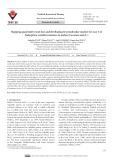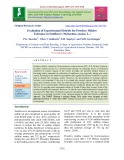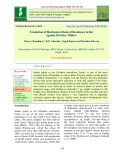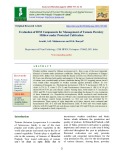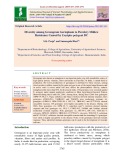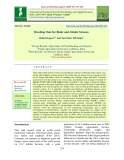
Powdery mildew resistance caused
-
Powdery mildew of melon caused by the Podosphaera xanthii factor is a disease that causes serious yield losses economically in all areas where melon is grown from Asia to Europe and America. The use of resistant varieties for the control of the disease is the most environmentally friendly method. However, traditional methods of melon breeding have made a noteworthy input to resistance varieties improvement, but they have been slow and incompetent in targeting complex powdery mildew disease resistance traits.
 11p
11p  lyhuyenthu
lyhuyenthu
 31-01-2023
31-01-2023
 6
6
 2
2
 Download
Download
-
Powdery mildew caused by the fungal pathogen Erysiphe necator is a global disease that reduces yield and quality in grapes (Vitis vinifera L.). Most grape cultivars are susceptible to this pathogen and thus the selection of powdery mildew resistant cultivars is a major objective of grape breeding programs. In this study, we evaluated powdery mildew resistance of a diverse set of 28 commonly cultivated local and international V. vinifera cultivars after artificial inoculations with Erysiphe necator.
 13p
13p  hanthienngao
hanthienngao
 30-11-2021
30-11-2021
 15
15
 1
1
 Download
Download
-
Powdery mildew caused by Golovinomyces cichoracearum (DC.) V.P. Heluta (formerly Erysiphe cichoracearum) is a common foliar disease on senescing leaves of cultivated sunflower in warmer regions of the world. In India, the powdery mildew disease is becoming major constraint in cultivation of sunflower crop especially during post rainy season. Screening of the sunflower germplasm lines against the disease would be of a great help to identify the resistance source.
 13p
13p  nguaconbaynhay8
nguaconbaynhay8
 13-10-2020
13-10-2020
 9
9
 2
2
 Download
Download
-
Indian jujube or ber (Ziziphus mauritiana Lamk.) is one of the most common fruit of Rajasthan as well as India. Powdery mildew of ber incited by Oidium erysiphoides f. sp. ziziphi, Yan and Wang is the most important disease that causes maximum reduction in yield and quality of ber fruits. An increase in total phenols and decline in total soluble solids and ascorbic acid content were observed in fruits of infected plants at peanut and immature stages with Oidium erysiphoides f. sp. ziziphi compared to the healthy ones.
 6p
6p  caygaocaolon6
caygaocaolon6
 30-07-2020
30-07-2020
 6
6
 2
2
 Download
Download
-
Powdery mildew, caused by Blumeria graminearum f.sp. tritici (Bgt), is one of the most severe fungal diseases of wheat. The exploration and utilization of new gene resources is the most effective approach for the powdery mildew control.
 17p
17p  vihashirama2711
vihashirama2711
 21-05-2020
21-05-2020
 10
10
 0
0
 Download
Download
-
Powdery mildew caused by Oidium neolycopersici L. Kiss is one of the most important diseases of tomato under polyhouse conditions. During 2014-15, polyhouses of Kangra district (H.P., India) were surveyed and the disease severity was observed between 5.0 to 89.5 per cent affecting both quality and quantity of the harvest. Fourteen hybrids/cultivars of tomato were screened under p house conditions during 2014-15 cropping season, but all were found either susceptible or weakly resistant against powdery mildew.
 11p
11p  nguaconbaynhay5
nguaconbaynhay5
 16-05-2020
16-05-2020
 9
9
 1
1
 Download
Download
-
Powdery mildew (PM) is a widespread fungal disease of plants in temperate climates, causing significant economic losses in agricultural settings. Specific homologs of the MLO gene family are PM susceptibility factors, as their loss-of function results in durable PM resistance (mlo resistance) in several plant species.
 11p
11p  vishikamaru2711
vishikamaru2711
 25-04-2020
25-04-2020
 10
10
 1
1
 Download
Download
-
Podosphaera aphanis, a predominately biotrophic fungal pathogen, causes significant yield losses of strawberry. China is the largest strawberry producer in the world, and selecting for powdery mildew-resistant cultivars is desirable. However, the resistance mechanism against P. aphanis in the octoploid strawberry remains unclear.
 18p
18p  viuchiha2711
viuchiha2711
 21-04-2020
21-04-2020
 6
6
 1
1
 Download
Download
-
Pea powdery mildew is an air-borne disease of worldwide distribution. It is particularly damaging in late sowings or in late maturing varieties. It is caused by Erysiphe pisi. In order to bring residue free peas, there is need to manage these diseases through ecofriendly measures such as by using the chitosan which is antifungal as well as induces resistance in plants. GI chitosan is a deacetylated derivative of chitin obtained by gamma irradiation of chitosan.
 7p
7p  nguaconbaynhay4
nguaconbaynhay4
 22-03-2020
22-03-2020
 14
14
 2
2
 Download
Download
-
Greengram also known as mungbean is an important pulse crop with remarkable source of high quality protein, vitamins, fibres and amino acid profiles. In India, it stands third in production. The lower productivity of greengram is attributed to biotic stresses, among which powdery mildew caused by Erysiphe polygni is one of the major fungal diseases and in severe cases it covers entire leaf area, affects the photosynthetic activity, reduces mungbean yield more than 50%. In the present study, 130 genotypes were screened against E.
 7p
7p  cothumenhmong3
cothumenhmong3
 22-02-2020
22-02-2020
 16
16
 0
0
 Download
Download
-
Oats rank around sixth in world cereal production statistics, following wheat, maize, rice, barley and sorghum. In many parts of the world, oats are grown for use as grain as well as for forage and fodder, straw for bedding, hay, haylage, silage and chaff. Livestock grain feed is still the primary use of oat crops, accounting for an average of around 74 percent of the world’s total usage.In India, breeding of oats begun in nineteen-eighties and is grown as the most important cereal fodder crop in North Western, Central India, extending to the eastern regions.
 10p
10p  nguaconbaynhay3
nguaconbaynhay3
 07-02-2020
07-02-2020
 20
20
 0
0
 Download
Download
CHỦ ĐỀ BẠN MUỐN TÌM








